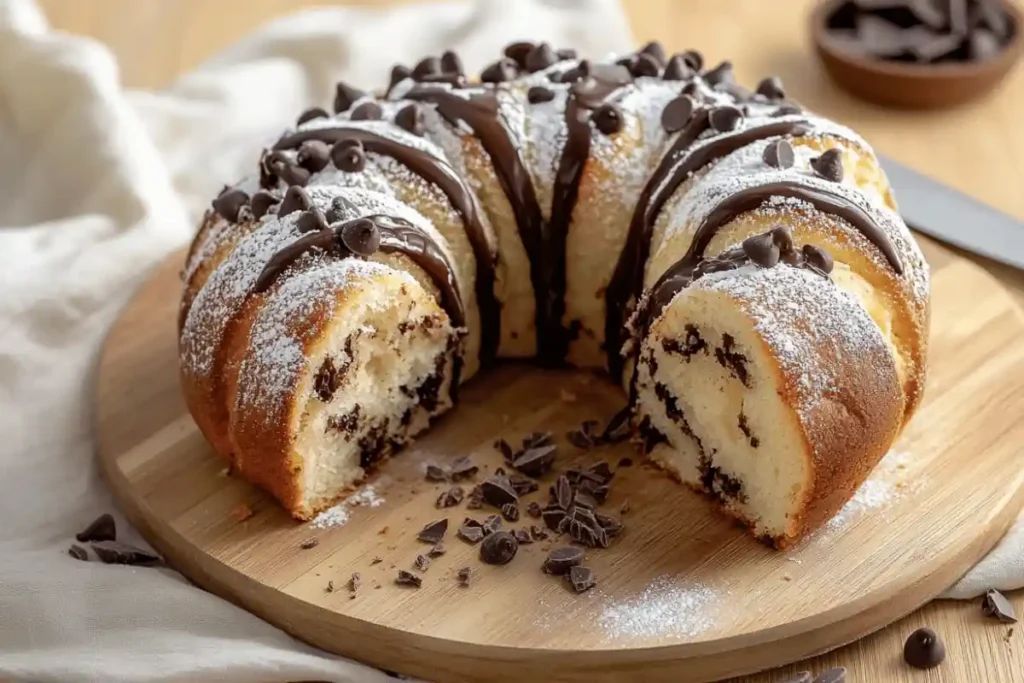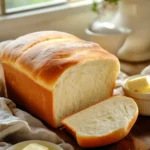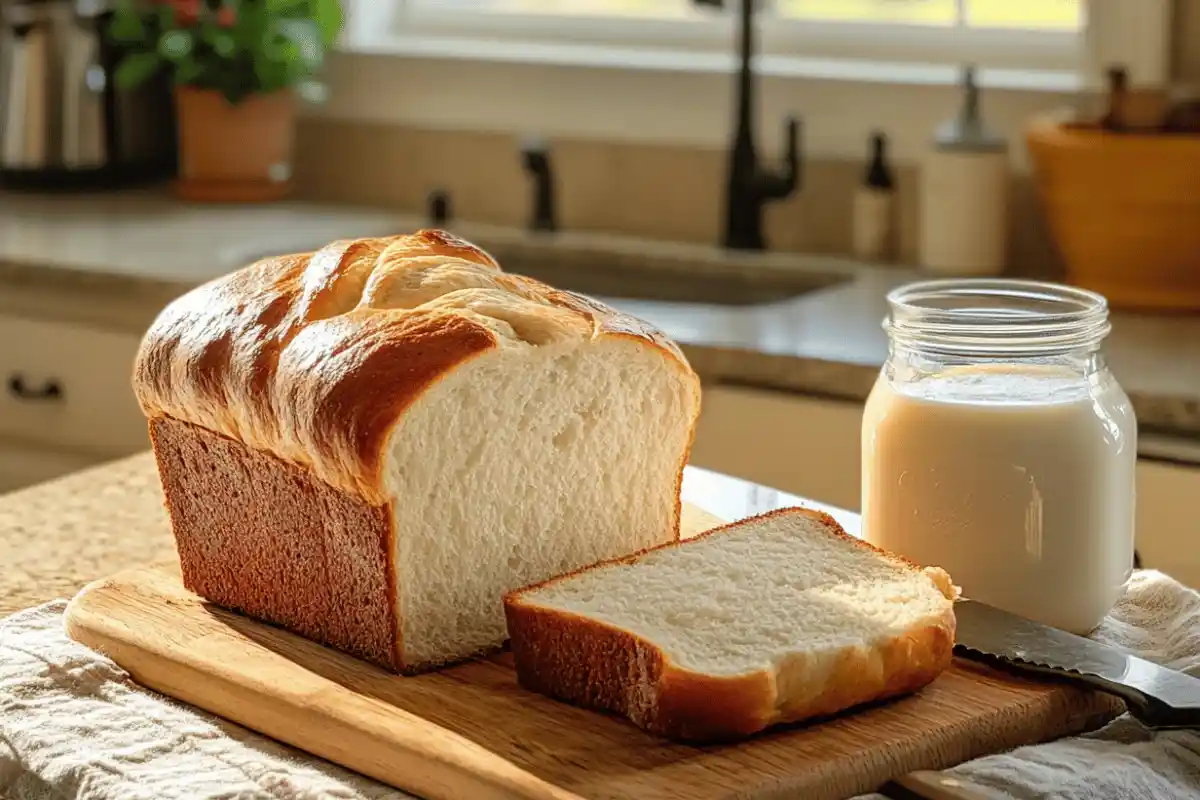Introduction to Condensed Milk Bread
If you’ve got a soft spot for homemade bread, then condensed milk bread is about to be your new favorite treat! This bread is fluffy, sweet, and super easy to make, which is why it’s beloved worldwide. With its soft bread texture and subtle sweetness, condensed milk bread has been taking over kitchens, and for good reason! In this comprehensive guide, we’ll dive into what makes condensed milk bread so special, explore the step-by-step recipe, discuss the nutritional benefits, and offer troubleshooting tips to ensure your loaf turns out just right. Ready to get baking? Let’s get started!
Table of contents
What Is Condensed Milk Bread?
Also known as sweet milk bread, is a delightful and incredibly fluffy bread made with—you guessed it—condensed milk! This star ingredient lends a slight sweetness and soft texture, which makes each bite utterly satisfying. Inspired by Japanese milk bread, this loaf is different from your everyday bread because of its tender crumb and rich flavor. The addition of condensed milk elevates the moisture content, making it a melt-in-your-mouth experience.
The Origin of Condensed Milk Bread
Condensed milk bread draws its inspiration from Asian bread-making traditions, particularly the popular Japanese milk bread. With its soft, pillow-like consistency, it was an instant hit and found a home in households worldwide. Whether you’re a seasoned baker or just starting out, you’ll find that the combination of condensed milk and bread-making is truly a match made in heaven.
Why Is Condensed Milk Bread So Popular?
Condensed milk bread has gained immense popularity for a few reasons. First off, it’s delicious! The fluffy bread recipe has just the right amount of sweetness, thanks to the condensed milk. It’s perfect for any occasion—whether you need a breakfast option, a snack, or even dessert. Moreover, it’s surprisingly easy to make, with straightforward steps that almost anyone can follow. People love its versatility and the easy bread recipe format that doesn’t require fancy skills or equipment.
The Role of Condensed Milk in Bread Making
When it comes to baking with condensed milk, it’s not just about sweetness. Condensed milk adds a velvety texture to the bread, giving it that rich, creamy quality that distinguishes it from other loaves. It also helps with the bread rising, giving you that perfect soft, puffy loaf every time. It’s no wonder condensed milk has become a favorite ingredient in many sweet bread recipes around the world.
Ingredients Needed for Fluffy Dairy Bread
To make the perfect Fluffy Dairy Bread, you’ll need a few simple ingredients that are likely already in your pantry. Here’s a detailed breakdown:
- All-Purpose Flour: This is the base of any good bread, providing essential structure and support. Flour forms the foundation that helps all the ingredients bind together smoothly.
- Instant Yeast: Yeast plays a crucial role in helping the dough rise, thus ensuring a fluffy, soft texture. Moreover, using instant yeast makes the process faster and more convenient.
- Condensed Milk: This is the star ingredient! It not only adds subtle sweetness but also keeps the bread moist and tender. The richness of condensed milk makes each bite a satisfying experience.
- Warm Milk: Adding warm milk enhances the dough’s moisture content, activating the yeast more effectively for an optimal rise. It also contributes to the bread’s overall richness.
- Butter: Butter adds a creamy richness, making the bread tender and adding a touch of indulgence. It also improves the flavor, making each bite more enjoyable.
- Egg: Eggs contribute significantly to the bread’s structure. They provide strength, enhance the color, and help bind all ingredients, resulting in a beautifully golden loaf.
- Salt: Salt is essential for enhancing the overall flavor of the bread. It balances the sweetness and brings out the taste of each ingredient, making the final result even more delicious.
These ingredients come together seamlessly to create that irresistible, soft bread texture we all love. By combining them in just the right way, you’ll achieve a loaf that’s wonderfully light, tender, and utterly enjoyable.
Essential Tools for Making
Before diving into the recipe, make sure you have these tools ready:
- Mixing Bowl: To combine all the ingredients.
- Whisk and Wooden Spoon: For mixing the wet and dry ingredients.
- Measuring Cups and Spoons: To measure everything accurately.
- Stand Mixer with Dough Hook: Optional but makes kneading the dough much easier.
- Baking Tin: For shaping and baking your loaf.
- Kitchen Towel: To cover the dough while it’s rising, ensuring it doesn’t dry out.
Having the right tools makes the process seamless, so don’t overlook these essentials!
How to Make Condensed Milk Bread: Step-by-Step Recipe
This is the heart of the article, and here’s where the magic happens! Follow these easy steps to make your very own fluffy condensed milk bread:
Preparing the Ingredients
- In a small bowl, mix 1 tablespoon of yeast with 1/4 cup of warm milk (make sure it’s warm but not hot) and let it sit for about 5-10 minutes, until it becomes frothy.
- In a separate large mixing bowl, whisk together flour, salt, and sugar until well combined.
Mixing and Kneading
- Pour the frothy yeast mixture into the flour mixture. Add in the condensed milk, warm milk, and egg.
- Stir until a sticky dough starts to form. If you have a stand mixer, use the dough hook attachment and knead for about 5 minutes.
- Add butter, one tablespoon at a time, kneading between additions. Continue kneading until the dough is smooth and elastic (about 10 minutes by hand or 6 minutes using a stand mixer).
Proofing the Dough
- Shape the dough into a ball, place it in a lightly greased bowl, and cover it with a kitchen towel.
- Let the dough rise for 1-2 hours, or until it has doubled in size. You can place it in a warm environment to speed up the rising process.
Shaping and Baking

- Once doubled in size, punch the dough down to release air bubbles. Turn it out onto a lightly floured surface and divide into even pieces.
- Roll each piece into a smooth ball and place them in a greased baking tin. Cover again and let them rise for an additional 30 minutes.
- Preheat your oven to 350\u00b0F (180\u00b0C).
- Brush the top with milk or a beaten egg for a shiny crust, then bake for 25-30 minutes or until golden brown on top.
- Allow it to cool slightly before slicing and serving.
Pro Tips for Making the Perfect Condensed Milk Bread
- Use Room Temperature Ingredients: It helps the dough rise more consistently.
- Don’t Skip the Second Proofing: This is crucial for that fluffy texture we all love.
- Watch the Oven Temperature: Every oven can vary, so make sure to keep an eye on the bread as it bakes.
Pro Tips for Making the Perfect Condensed Milk Bread
- Use Room Temperature Ingredients: It helps the dough rise more consistently.
- Don’t Skip the Second Proofing: This is crucial for that fluffy texture we all love.
- Watch the Oven Temperature: Every oven can vary, so make sure to keep an eye on the bread as it bakes.
Nutritional Information (per 100g)
| Nutrient | Amount |
| Calories | 280 kcal |
| Carbohydrates | 45 g |
| Protein | 7 g |
| Fat | 8 g |
| Saturated Fat | 5 g |
| Cholesterol | 45 mg |
| Sodium | 240 mg |
| Sugars | 10 g |
| Fiber | 1 g |
| Calcium | 60 mg |
Delicious Variations
One of the best things about condensed milk bread is its versatility. You can put your own twist on this classic bread by adding flavors and extra ingredients that suit your taste. Here are some variations that you can try:
Adding Flavors like coconut, Chocolate or ube extract:

- Cinnamon Swirl: Want to add a bit of spice? Mix a tablespoon of cinnamon with a bit of sugar and sprinkle it over the dough before rolling it up. This creates a delightful swirl and adds a warm, aromatic taste to the bread.
- Chocolate Chips: For all the chocolate lovers, add a handful of chocolate chips into the dough during mixing. The melted chocolate combined with the soft bread makes for an indulgent treat!
- Raisins and Nuts: Add some raisins and chopped nuts to create a more textured bread. It adds a lovely contrast to the soft, tender crumb of the bread, making it ideal for breakfast.
- Ube Extract: Adding ube extract brings a vibrant purple color and a subtle earthy sweetness to your bread. This variation adds a unique twist, making the loaf visually stunning and giving it a distinct flavor that pairs wonderfully with a cup of tea or coffee.”
- Coconut Ube Extract: Incorporate coconut and ube extract for an exciting fusion of flavors. The coconut adds a tropical flair, while the ube extract enhances the bread’s color and taste. This combination results in a soft, aromatic bread that is both visually appealing and delicious, perfect for sharing at gatherings or enjoying as a special treat.
These variations will bring new life to your sweet bread recipe and keep it exciting every time you bake!
How to Store Condensed Milk Bread for Long-Lasting Freshness
Once you’ve made this homemade bread, it’s essential to store it properly so you can enjoy it at its best. Here’s how to do it:
- Room Temperature Storage: Wrap the bread tightly in plastic wrap or place it in an airtight container. This helps retain moisture and keep it soft for up to 3 days. Make sure it stays in a cool, dry spot—out of direct sunlight.
- Freezing Tips: If you want to keep the bread longer, freezing it is the best option. Slice the bread, wrap each slice individually, and store in a zip-top freezer bag. This makes it easy to pull out just the slices you need without having to thaw the entire loaf.
- Reheating: To enjoy the bread again, simply toast it lightly or warm it in the oven. The bread will regain its fluffy texture and fresh-baked taste.
Proper storage ensures that your condensed milk bread remains soft, moist, and tasty for as long as possible, so you can savor every bite without worry.
Nutritional Information
Condensed milk bread is not only delicious but also has some nutritional benefits. While it’s on the sweeter side, it does contain essential nutrients that can be a part of a balanced diet.
- Calories: A typical serving of condensed milk bread contains around 280 calories, providing an energy boost.
- Carbohydrates: This bread is high in carbohydrates, which are an excellent source of quick energy, making it a good breakfast choice.
- Protein: With the addition of eggs and milk, this bread contains a moderate amount of protein, which helps in muscle growth and repair.
- Calcium: The condensed milk adds calcium, which is vital for bone health.
Condensed milk bread is a great choice for a treat that balances indulgence with a few nutrients to benefit your health.
How to Serve Condensed Milk Bread: Delicious Pairings
One of the things that makes condensed milk bread so special is its versatility in serving. Here are some ways to enjoy this soft and delicious bread:
Breakfast Ideas
- Toasted with Butter and Jam: Start your day by lightly toasting a slice of Fluffy Dairy Bread. Then, spread a generous layer of butter, followed by your favorite jam. The combination of creamy condensed milk flavor with the sweetness of the jam creates a heavenly breakfast treat. This simple yet delightful pairing is sure to make mornings more enjoyable.
- French Toast: You can easily transform sweet milk bread into the most luxurious French toast. The bread’s natural sweetness and fluffiness make it ideal for absorbing the egg mixture. As a result, you get a rich, tender, and satisfying French toast that pairs perfectly with maple syrup or fresh fruit.
Desserts and Snacks
- Bread Pudding: If you have day-old Fluffy Dairy Bread, use it to make a creamy bread pudding. The bread’s inherent sweetness complements the custard mixture perfectly, resulting in an indulgent and comforting dessert. Adding some raisins or a touch of cinnamon can further enhance the flavors.
- Nutella Sandwich: For a quick snack, create an irresistible Nutella sandwich by slathering a thick layer of Nutella between two slices of Fluffy Dairy Bread. The soft, tender bread and the rich chocolate hazelnut spread combine to create a treat that’s guaranteed to satisfy your cravings. Whether for a midday snack or an after-school treat, this sandwich is always a hit.
Whether you’re eating it for breakfast, turning it into a decadent dessert, or simply having it as a snack, condensed milk bread is a versatile treat that can satisfy many cravings.
Troubleshooting Common Issues with Condensed Milk Bread
Even the most experienced bakers can encounter challenges when making condensed milk bread. Here are some common problems and how to solve them:
- The Bread Didn’t Rise: If your bread isn’t rising, it’s likely an issue with the yeast. Make sure your yeast is still active by proofing it in warm (not hot) milk. Yeast needs warmth to activate, but too much heat will kill it.
- Dense Bread: If the bread turns out dense instead of fluffy, it could be due to insufficient kneading. Kneading develops gluten, which is crucial for creating that soft and airy texture. Use a stand mixer if possible to knead the dough well.
- Crust Too Hard: If the crust is too hard, you may have overbaked it. Make sure to check the bread about 5 minutes before the recommended baking time to see if it’s already golden brown. Additionally, brushing the top with milk before baking helps to keep the crust soft.
These tips should help you troubleshoot and ensure that your sweet milk bread comes out perfectly soft and fluffy every time!
Frequently Asked Questions
Why Is My Condensed Milk Bread Not Rising?
Your bread may not rise due to inactive yeast or cold temperatures. To solve this, always check that your yeast is frothy before mixing it with the flour. Additionally, place your dough in a warm environment while proofing. A tip is to put the dough in the oven (switched off) with a bowl of hot water nearby to create a warm and humid space.
Can I Use Evaporated Milk Instead of Condensed Milk?
No, evaporated milk and condensed milk are not interchangeable in this recipe. Condensed milk is sweetened and has a thicker consistency, which gives the bread its unique texture and flavor. Evaporated milk lacks the sweetness and creaminess, which would significantly alter the final bread.
How Do I Make Condensed Milk Bread Dairy-Free?
If you are looking to make a dairy-free version of condensed milk bread, you can substitute the condensed milk with coconut condensed milk, which is widely available in stores. Additionally, replace the regular butter with a plant-based alternative. The result is a slightly different but still delicious dairy-free loaf.
These FAQs address the most common questions, ensuring that everyone—regardless of experience or dietary needs—can enjoy making condensed milk bread successfully.
Conclusion: Why You Should Try Making Condensed Milk Bread
Condensed milk bread is the perfect combination of flavor, texture, and simplicity. Whether you’re a beginner baker or an experienced pro, this bread is incredibly rewarding to make and versatile in its uses. With its soft bread texture and slightly sweet flavor, it’s ideal for breakfast, a snack, or even a comforting dessert. Plus, with our step-by-step recipe and troubleshooting tips, you’re well-prepared to bake this wonderful bread at home. So, why not give it a try? You’ll be amazed at how such simple ingredients can create something so delicious.
Print
Homemade Condensed Milk Bread
- Total Time: ~2 hours 30 minutes (includes proofing)
- Yield: 1 loaf (~12 slices) 1x
Description
This soft and fluffy condensed milk bread is a melt-in-your-mouth treat with just the right amount of sweetness. Made with pantry staples and rich condensed milk, it’s perfect for breakfast, snacks, or dessert. This versatile bread rises beautifully and is easy enough for beginner bakers to master.
Ingredients
-
3 ½ cups all-purpose flour
-
2 ¼ teaspoons instant yeast (1 packet)
-
½ cup condensed milk
-
1 cup warm milk (110°F)
-
1 large egg
-
4 tablespoons unsalted butter, softened
-
1 tablespoon sugar (optional)
-
1 ½ teaspoons salt
Instructions
-
Activate Yeast
Mix yeast with ¼ cup warm milk and let sit for 5–10 minutes until frothy. -
Mix Dry Ingredients
In a bowl, whisk flour, salt, and sugar. -
Combine and Knead
Add yeast mix, condensed milk, warm milk, and egg. Mix until dough forms. Knead 8–10 mins by hand or 5–6 mins in stand mixer. Add butter and knead until smooth. -
First Rise
Shape into a ball and place in a greased bowl. Cover and proof for 1–2 hours until doubled. -
Shape & Second Rise
Punch down, divide and shape. Place in a greased baking tin. Cover and rise for 30–45 mins. -
Bake
Preheat oven to 350°F (180°C). Brush top with milk or egg wash. Bake 25–30 mins until golden brown. -
Cool & Serve
Cool slightly on rack before slicing.
Notes
-
Use room temp ingredients for better proofing.
-
For a soft crust, brush with milk pre-baking.
-
Add chocolate chips, ube extract, or cinnamon for variations.
- Prep Time: 20 minutes
- Cook Time: 30 minutes
- Category: Bread
- Method: Baking
- Cuisine: Asian-inspired
Nutrition
- Serving Size: 1 slice (approx. 50g)
- Calories: 140 kcal
- Sugar: 5 g
- Sodium: 120 mg
- Fat: 4 g
- Saturated Fat: 2.5 g
- Carbohydrates: 22.5 g
- Protein: 3.5 g
- Cholesterol: 22.5 mg
Keywords: sweet milk bread, fluffy dairy bread, Asian bread recipe, Japanese milk bread, easy homemade bread, condensed milk baking
